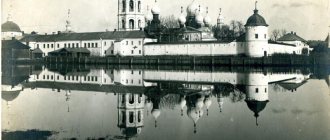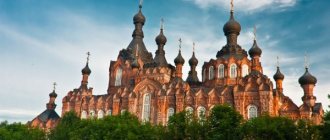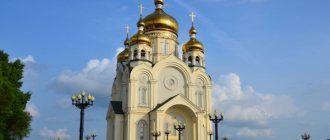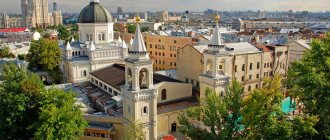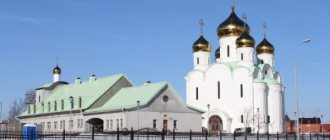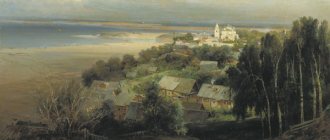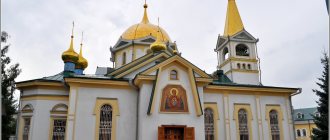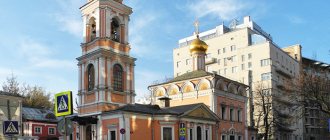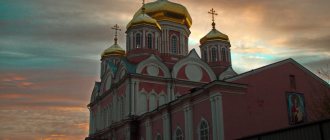John the Baptist Monastery in Astrakhan is a place interesting not only from a religious, but also from a historical point of view. The architectural dominant of the monastery is the temple in honor of the Beheading of John the Baptist (previously called Sretensky). The five-domed temple pleases the eye with its majesty and elegance. The red color gives it a festive look, and the decorative patterns on the facade resemble wooden carvings. The temple has 3 chapels: the main one is dedicated to the Beheading of John the Baptist, the right one is consecrated in honor of the Iveron Mother of God, the left one is in honor of St. Tikhon of Zadonsk.
This is the only surviving temple on the territory; others were demolished during the persecution of the church in the 30s of the 20th century. After many years of atheism reigning in the country, the monastery was again returned to the Orthodox Church in 1989. Thanks to the work of the abbots and brethren of the monastery, and donations from parishioners, during this time it was possible to restore many buildings and erect new fraternal buildings. There are plans to restore the bell tower to its historical appearance.
Panorama of the St. John the Baptist Monastery in Astrakhan on Yandex. Maps:
History of the monastery
Astrakhan first mentions the St. John the Baptist Monastery in the chronicle of 1688 in connection with Elder Alexander’s petition to the Metropolitan regarding the construction of a church. The exact date of the establishment of the monastery is unknown, but the petitioner was a monk and belonged to an existing monastery. This means that the period of the emergence of the community preceded the indicated events.
The monastery is located on the Kutum River, on a hill on the southern bank, which is called Red Hill. The construction was carried out with the donation of personal money from the Monk Savvaty, who at that time held the rank of Metropolitan of Astrakhan.
Over the 320 years of its existence, the monastery has experienced many ups and downs. He has accounted for more than one epoch-making milestone in the life of the building, the brethren, Astrakhan and Russia.
Thus, the Streltsy uprising of 1706 led to the capture of Astrakhan by rebels. Troops from Moscow under the leadership of Field Marshal Sheremetyev arrived to the rescue. The walls of the monastery were penetrated through loopholes, and fierce fighting took place. Under the protection of the monastery armor, the royal people held out and repelled the attack.
St. John the Baptist Monastery was closed in 1723 after a conflict between the governor of Astrakhan and the abbot.
The building was handed over to the garrison hospital. The monks were dispersed. But the service at the shrine did not stop even for a day. The traditions were picked up by priests who were not in disgrace. After 4 years, the monastery returned to the diocese. A stone fence was erected around it and a 2-story building of abbots was built.
The abbot's house was demolished in 1895, and a two-story stone one was erected in its place. The lower floor was given over to the church school. By the beginning of the last century, the community consisted of 14 people. Two years after the socialist government came to power, the monastery was closed.
The temples existed for another 10 years, after which the cathedral, church and bell tower were demolished. The remaining buildings were redeveloped into apartments and outbuildings. 1992 marked the revival of the monastery. First, the remaining Church of the Presentation of the Lord was put in order. Galvanized domes were installed in a place of honor.
The concrete pavement along the perimeter of the building was restored, a temporary bell tower and auxiliary buildings were erected: a boiler room, warehouses. In 1989, the ceiling was repaired, the crosses on the domes were covered with gold, the window frames, glazing, and doorways were replaced, and the main staircase was restored.
The interior walls were painted with biblical scenes. The first Liturgy was held in 1993, and the cathedral was filled with parishioners. Two years later, monasticism resumed at the St. John the Baptist Monastery. During the same period, the main attribute was installed in the center of the prayer room - a wooden carved iconostasis. Believers donated funds for its production.
The next stage of restoration work took place in 2001. The iconostasis was improved, the place for singers was rebuilt, which freed up additional space, and in 2006 the lining of the domes was changed to “golden.” The monastery became the central, significant place of the city, its decoration, its calling card.
Godless acts of the governor
However, even after the Streltsy revolts subsided, peace and tranquility did not reign for long in the monastery. In the twenties of the same 18th century, the Astrakhan governor A.P. Volynsky became a troublemaker. As is known, he patronized Catholic missionaries who launched their activities in the Volga region. On this basis, he had a conflict with all representatives of the clergy, who expressed dissatisfaction with his actions.
Among them was Archimandrite Joasaph, who headed the St. John the Baptist Monastery (Astrakhan). Having imprisoned the servant of God, he tried to force him to hand over the monastery treasury and other valuables, previously hidden from possible theft. Only an accident allowed the abbot to escape and thereby save his life.
Having not succeeded in his crime, the godless governor nevertheless achieved in 1723 the closure of the monastery and the establishment of a military hospital within its walls. All monks were expelled, and the monastery church received parish status. Divine services continued there, but it was in the hands of the white, that is, non-monastic clergy. Only four years after the urgent demands of the diocesan bishop, Bishop Varlaam, the St. John the Baptist Monastery (Astrakhan) again continued its activities.
Architect and exterior decoration of the cathedral
Of all the previously existing buildings belonging to the monastery, only the church, erected in 1899, has survived. After persecution and destruction, in 1989 the building was transferred to the ownership of the church and was subject to restoration. The temple was consecrated and given its name in honor of a significant Christian event: the Beheading of John the Baptist.
John the Baptist Monastery (Astrakhan) before restoration
The project architect is unknown. Construction work was carried out under the leadership of I.A. Khramov. 75,000 rubles were spent on materials and payment to the contractor. The building is basically rectangular in shape.
Additional buildings adjoin the church on each side:
- altar - from the east;
- the central vestibule is on the western side;
- side porches - on the north and south.
As a result, the projection of the building corresponds to a cruciform configuration. All three entrances have semicircular ceilings, and the central one has a tent roof with a dome and a cross. The temple is tall and is crowned with five domes located on two rows of semicircular decorative elements. Patterns reminiscent of women's kokoshniks run across the entire perimeter of the building. The domes are decorated with eight-pointed crosses.
The building was erected in the style of ancient Russian architecture. Outwardly it looks light, airy, directed upward. The facades are decorated with red and yellow bricks with decor in a pseudo-Russian style.
Don't miss the most popular article in the section: Metro Nizhny Novgorod. Diagram, map, description.
Shrines of St. John the Baptist Monastery
Faith produces many wonderful things. Of course, the site for the construction of the monastery was chosen by ordinary people, and not by signs, like the Leushinsky St. John the Baptist Convent. But for so many years, thanks to faith and worship, the Moscow monastery has earned the glory of being miraculous.
Over the centuries-old history, this place has accumulated enough objects for worship. In addition to miraculous icons, the monastery contains pieces of holy relics:
- St. John the Baptist.
- Venerable Alexy.
- Apostle Matthew.
- St. Nicholas the Wonderworker.
- Healer of the Great Martyr Panteleimon and many others.
Architectural ensemble of the cathedral
St. John the Baptist Monastery Astrakhan opens up to visitors with an architectural ensemble, which includes a cathedral and a belfry.
Additional elements are considered:
- central gate;
- fencing;
- abbot's house;
- auxiliary premises;
- monastic corps;
- bath;
- east gate;
- former refectory.
You can enter the monastery through the Holy Gate, the roundness of which is crowned with a golden dome, decorated with a cross, betraying solemnity and decorum. The oldest building, built in 1895, is the abbot’s house. It contains a library, a choir practice room, church school rooms and a vestry.
One of the corners of the building is crowned with a turret with a helmet-shaped ceiling and an angel at the top. In 2002, the building was returned to the church.
The two-story building for the residence of monks has been in operation since 2001. The cells of the brethren are located on the top floor. A bright dining room, a carpentry workshop, a garage and a lecture hall are located on the lower level. The plans of the monastery brethren include the construction of the lost bell tower.
Currently, its functions are performed by a belfry with 9 bells. Godly monastery chimes spread far across the city, bringing great joy to believers.
The monastery church occupies a central place in the holy courtyard. The building rises above the monastery buildings, is well lit, looks beautiful in any season, regardless of the weather. The glare of the sun, reflected in the domes, creates the effect of a fiery shimmer. The stone pattern of the walls resembles wood carvings.
Interior decoration
At the beginning of the 20th century, the temple had material and spiritual treasures at its disposal. Rich interior decoration, paintings, and ancient shrines adorned the St. John the Baptist Monastery.
All greatness was lost during Soviet rule. During the restoration period, the interior walls were painted in academic style with sacred images.
The icons located on the central three-tier iconostasis are made in an identical manner.
The floor of the hall is tiled. A chandelier with candles in 4 tiers descends from the dome, illuminating the salt. Each area has its own iconostasis in 2 tiers. Green shades of the painting create calm and tranquility.
John the Baptist Convent (Vyazma)
Many churches and temples were built in the name of the great Prophet. In Russia, in addition to the Moscow monastery of the same name, the St. John the Baptist Convent (Vyazma) is also known. It was founded in the Smolensk region, according to various sources, in 1536 or 1542.
At the beginning of the monastery's history, Russian sovereigns Boris Godunov and Ivan the Terrible visited it. It experienced the period of Troubles and wars in almost the same way as other monasteries. It has been robbed and destroyed many times, and its original appearance can no longer be seen.
In the 18th century, a special seminary was organized here, and then a Theological School. During the Soviet period, most of the complex was destroyed, and restoration work is ongoing to this day.
Shrines and relics of the monastery
Astrakhan preserves the St. John the Baptist Monastery as a historical heritage, which houses a particularly revered ancient image of the Iveron Icon of the Mother of God, acquired by Hieromonk Philip (Trishchev).
Prayers said before the Mother of God are often fulfilled, therefore, since 1998, a weekly akathist has been read in honor of the icon. The love and veneration of the ancient image is evidenced by the large quantities of donations made of expensive metals surrounding it.
Icons with particles of the relics of St. Tikhon and St. Maxim the Greek are venerated; they are newly painted, appeared, found in 1995.
Famous inhabitants of the monastery
A variety of people, from different classes and different ages, visited here at different times. And, of course, they each had their own reasons. Believers came here, with a difficult fate or to atone for sins.
During the years of tsarism, the St. John the Baptist Convent was almost entirely supported by the money of the grand dukes. The entire wealthy class made certain contributions and participated in the life of the monastery. Towards the end of their lives, members of noble families moved here. This is where they buried their dead relatives. And the monastery became a family abode for those in power.
But it was not only volunteers who took monastic vows. By royal decree, people objectionable and dangerous to the authorities were exiled to the monastery. One of the most famous inhabitants at the turn of the troubled 18th-19th centuries was the famous princess Augusta Tarakanova. She, as the direct heir to the throne, the daughter of the secret marriage of Elizaveta Petrovna and Razumovsky, was forcibly tonsured and deprived of the opportunity to live freely.
The famous torturer of peasants, Saltychikha, was also imprisoned here. She is responsible for more than 140 ruined souls. Daria Saltykova spent 11 years in the crypt. Then she was forced to live in a special open cage, in full view of all the parishioners.
There were also holy fools here, who were revered as saints. For example, the story tells about the schema-nun Martha. She was revered by Mikhail Fedorovich’s wife as an assistant during childbirth. And even after Martha’s death, the custom remained to serve at her grave for the successful resolution of pregnancy.
Service schedule, operating hours
Services are held daily at 7.30 (8.30 on holidays) and at 17.00. They come to confession at 7.30. In the mornings, at the end of the prayer, the services are served.
On Mondays at 17.30 and Fridays at 18.30 akathists are served. The sacrament of baptism is performed after morning prayer from Monday to Saturday, at 7:30 am on Sundays and holidays.
Rules for visiting the monastery
In order to avoid getting into an awkward position, you need to know the basic rules of behavior in the monastery.
- When addressing a clergyman with a question or request, the palms of the hands are folded crosswise. This gesture speaks of greeting, trust in the church minister, humility and obedience. Answering a question, the priest blesses the questioner in the name of Christ.
- Any questions about spiritual life should be addressed to a priest who has a blessing, and not to the first monk you meet.
- The leader of the tourist group receives a blessing to conduct the excursion.
- You can visit the monastery refectory for money, or free of charge for poor or needy people with the blessing of the abbot. During lunch, the lives of the saints are read, which is a continuation of the service. You cannot get up from the table until the reading is finished.
- The clothing of secular people must comply with the rules of life of the monastery. Women should not wear trousers. A skirt that covers the knees or goes to the floor is suitable for going to a monastery. The head, neck, and shoulders are covered with a scarf or clothing.
- Men should not wear a tracksuit, shorts, or short sleeves. Upon crossing the threshold of the monastery, the headdress is removed. On holidays, beautiful elegant clothing is recommended
- When entering the monastery territory, you must turn off your mobile phone. Better yet, leave it at home. Here it is customary to keep in touch with God and, at least for a while, step away from worldly affairs.
- According to generally accepted laws, photography in the temple during services is prohibited. This bothers the people around you.
- You can enter the temple to pray at any time, only at night the doors are closed. But the most powerful action occurs during the service, when all those present are converted in a single impulse, “Lord have mercy.”
- When entering the church, bowing from the waist to icons and relics is recommended.
- It is not at all necessary to light candles in the church and buy monastery products. If a candle is lit, then a prayer and repentance are said. The funds spent on purchases on the territory of the monastery are donations for the needs of the monastery.
Patronal holidays
Dates associated with the lives of the saints in whose honor the temple and its altars were consecrated are called patronal feasts.
For the St. John the Baptist Monastery, these are memorial dates for three saints:
- Icon of the Most Holy Theotokos “Iverskaya”: October 26, February 25, May 6;
- John the Baptist, prophet: July 7 (Christmas), September 11 (Beheading), October 6 (Conception), January 20 - Council;
- In memory of St. Tikhon of Zadonsk: August 1; August, 26th.
Saint John the Baptist
This saint is revered almost as much as the Virgin Mary herself. After all, it was he who announced the future birth of Christ. And therefore, a huge number of temples and churches were erected in his honor, both in Russia and in the world. One of the most famous is the St. John the Baptist Convent in Moscow.
This extraordinary child was born into the family of clergymen Zechariah and Elizabeth. Archangel Gabriel predicted his appearance to his father. He said that the unborn child is the Forerunner of the great messiah. Not believing it, Zechariah paid with muteness.
Until the age of 30, John was in the desert. He led the life of a righteous man, for which he earned the respect and worship of the people of Jerusalem. People often came to him to receive the great sacrament of baptism. According to legend, Christ himself came to John. There, in the desert, in the Jordan River, he was baptized.
For his sermons and stories about the Messiah, as well as for denouncing many people in power, John the Baptist was beheaded. Subsequently, part of his relics were given to various monasteries as shrines.
Interesting facts about the cathedral
In Astrakhan, the St. John the Baptist Monastery is informally called “the church on the Great Isads.” This word form comes from the neighborhood of the market called “Big Isads”. In fact, over the long life of the cathedral, a long series of events took place in it.
Sometimes the monastery hosts exhibitions
| date | Event |
| 1895 | Beginning of construction of the three-altar church |
| 1899 | Completion of construction |
| July 25, 1899 | Sretensky Church was illuminated |
| September 13, 1909 | The right aisle of the temple is illuminated |
| August 13, 1910 | The left aisle of the temple is illuminated |
| Early 20th century | Master D. Shepelev painted the interior vaults and walls of the temple. Three-tiered iconostases were installed. |
| 30 XX century | Sretensky Church is closed for prayers |
| 1989 | Sretensky Church was returned to the church. Coverage took place |
| 1995 | Illumination of the right side of the temple |
| 1998 | Illumination of the left side of the temple |
| May 25, 2005 | Changing the domes to “golden” ones |
| 2006 | The next stage of restoration: restoration of the facade and paintings inside the building. Construction of an extension has begun to expand the area. |
| 2008 | Temple renovation |
| October 20, 2008 | Lighting |
Life continues in the monastery, the cathedral is active, which means that the chronicle of events will be replenished with interesting facts more than once.
Monastery on the Volga bank
In the middle of the 17th century, a monastery was founded next to the earthen rampart that protected Astrakhan from attacks by steppe nomads. It owes its birth to the diocesan bishop, Metropolitan Savvaty, who financed the first buildings from his personal funds. The archive contains documents indicating that in 1688, construction of a temple in honor of John the Baptist began on the territory of the monastery, led by Elder Alexander and carried out by the hands of the brethren themselves.
But, apparently, at that time the Lord was angry with the inhabitants of the Volga cities. In 1692, He allowed a terrible plague epidemic to break out, which also engulfed Astrakhan. John the Baptist Monastery (as it was called from the day of its foundation) shared a common fate - of all its inhabitants, only two hieromonks remained alive.
But everything is God’s will. The dead were buried in a brotherly cemetery, and their place was soon replaced by other monks and novices, who continued the work they had started and completed the construction of the temple in 1697. At the same time, a two-tier bell tower was erected over the holy gates - the western entrance to St. John's Monastery, and the entire territory was surrounded by strong walls with watchtowers at the corners. The times were turbulent, and often the holy monasteries had to act as military fortifications. That's what happened this time too.
Information for visitors
St. John the Baptist Monastery presents Astrakhan to tourists as a monument of art, causing delight and pleasure in the panoramas they see. During the service and festive chants, an understanding of the holiness of the action and a feeling of belonging to the origins of faith arises. The monastery is not only a religious institution, but also a cultural platform of Astrakhan.
A Sunday school is opened here, where children receive the basics of spiritual literacy. Pupils of the center for spiritual and moral education "Bogolep" take an active part in Orthodox and patriotic song competitions, in environmental landings and other cultural events. Children and adults attend lecture courses.
The monastery has organized a men's choir "Skimen" and a boys' choir. Children are given a full special music education, with the study of solfeggio, world artistic culture and vocals. When attending a concert or purchasing a CD, city residents and tourists can get in touch with academic music.
Another area of cultural and educational work of the monastery is a library with a reading room. It's quiet and peaceful here. The librarian on duty will help you choose literature; you can take books home with a subscription. The monastery publishes its own newspaper, “John’s Leaf.”
For tourists on the monastery territory there are shops selling recordings of church psalms, literature, and souvenirs.
Monasticism in Rus' has always been a godly act, revered by people. In the St. John the Baptist Monastery, despite the small number of inhabitants, a lot of work is being done to recreate and preserve material and spiritual values. In Astrakhan, the monastery is a revered canonical and cultural-educational institution.
Author: Marie Arkhipova
Article design: Mila Friedan
How to get to St. John the Theologian Monastery
You can get to the St. John the Theologian Monastery by bus No. 153 or minibus No. 139, heading in the direction of Ryazan-Central Bus Station. You need to get off at the Poshupovo stop, which is located opposite the Poshupovo supermarket. When you get off the bus, you can see the monastery immediately. From the stop you should walk along Moskovskaya Street and turn onto Monastyrskaya.
Transport stops near the monastery
You can get from Ryazan and nearby cities by taxi. Yandex services are available. Taxi, Maxim, Let's go and Lucky.
Report on the St. John the Theologian Monastery: video
